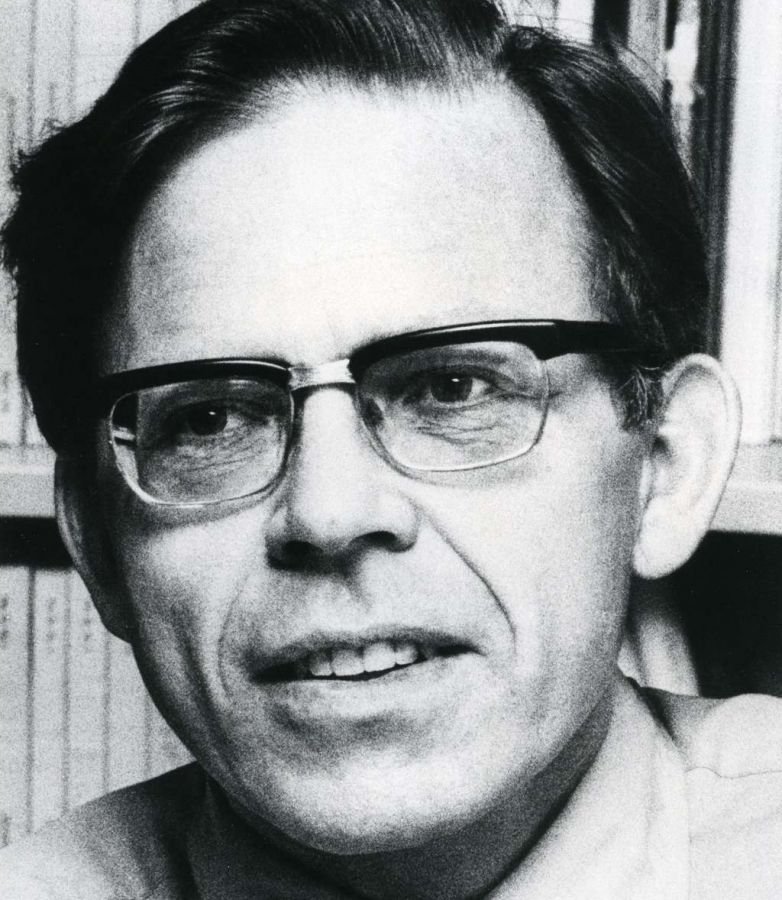Johansen in Norwegian biographical encyclopedia
Leif Johansen
Born 11. May 1930, Eidsvoll, Akershus; Died 29. December 1982, Oslo
Economist. Parents: Lieutenant Helge Kristian Johansen (1901-1988) and Louise Bundli (1905-1968). Married 1953 with library assistant Randi Marie Grønli (04.07.1931-), daughter of Alf Grønli typographer (1908-1961) and typographer Sigrid Othilie Grønli (1913-1995).
Johansen was richly endowed by nature, and school was easy. It was not until the end of high school that he needed to read the homework. He took his final exams at Sinsen higher general school in Oslo 1948, and good exam results also followed in studies at the University of Oslo. His Cand.oecon exam (1954) is probably the best ever taken.
Ragnar Frisch, Trygve Haavelmo and other teachers at the Institute of Economics were given early sight of Johansen and Frisch used him as an assistant while he was still a student - to the delight of both: Frisch had a dedicated and knowledgeable staff, and cooperation with the professor gave Leif Johansen a flying start as an independent researcher. The first scientific work came before he had completed the degree. Later came a steady stream of articles and papers, all of high quality. He mastered modern statistical theory and mathematical oriented economic theory.
A milestone was the doctoral dissertation A Multi-sectoral Study of Economic Growth (1960), a multi-sector model of economic growth that combined theory and empiricism. It was based on three parts of the modern economic theory: input-output analysis, neoclassical growth theory and the theory of consumer demand. The Johansen model could shed light on how the different sectors evolved during economic growth - some industries grew, others dwindled. He used the Norwegian statistics to quantify the relationships in the model, and it became an important tool in Norwegian planning. Over the years, the figures are regularly adjusted, but the actual structure of this "MSG" model is unchanged. It has become the most widely used model in the Norwegian planning, used by the Ministry of Finance under different governments and by scientists in the analysis of specific issues, eg. pollution and the environment, the need for different types of labor, accidents at work and work environment, the effects of the alternative use of petroleum revenues, the demand for electricity. The thesis was translated into several languages -- and foreign scientists constructed their own national MSG models.
Leif Johansen went ahead and immersed himself in the study of the economic production process. His contributions in this area also attracted international attention. A central idea was that the production process was bound by the technique lay in the permanent production equipment, while the technique could be selected before the investment took place.
As senior lecturer (from 1959) Johansen lectured on government fiscal policies; this was the basis for a textbook, Public economics, published from 1962 to 1964 and later in several editions, which was translated into several languages. It was part of the curriculum at universities and colleges in Norway and in other countries.
When Leif Johansen succeeded Ragnar Frisch as a professor in 1965, it was decided that he should especially lecture on financial planning. This led to his 1977-78 two-volume work on the principles of financial planning. The first volume dealt with general topics, while the second concerned centralization/decentralization and planning under uncertainty. Besides the works mentioned, Leif Johansen published a number of academic articles, several of them in leading international journals.
From childhood Leif Johansen had a strong political commitment. His father was a keen communist, and Leif joined the Youth League in the early years and was immersed in the life of the Communist Party. He was a member of the Executive Committee for 12 years, and there were those who wanted to see him in even more leading positions, but he chose the scientist's life. His research was rooted in neoclassical economic theory. He knew of course, Marxist economics, but it was not where he chose to work.
Leif Johansen's faith in communism was probably first and foremost rooted in a strong sense of justice, but he backed it too with economic arguments. He believed that the communist system would utilize resources better and creating a stronger economic growth than the capitalist. This was because it would carry a strong and detailed planning, and that it would abolish the private monopoly gain inherent in the patent system. Technical and economic insight should be openly available to all businesses, not just those who had patent rights.
In later years, Johansen saw how the planning system disintegrated in the Soviet Union, and he was interested in a certain element of the market economy system. In an article on Norway, he stressed that the largest firms should be transferred to the "social ownership" and that the government, next to taxes, fees, subsidies and benefits, should use direct measures - caps, regulation of the balance of payments, building permits and other rationing schemes. He also participated with the strong commitment of the EC conflict and was a member of the People's Movement against Norwegian membership of the EEC in 1970.
Leif Johansen was a member of the Norwegian Academy of Science (DNVA), The Econometric Society and science academies in Sweden and Denmark. He received the DNVAs Fridtjof Nansen-award in 1979. Personally, Johansen was a modest and likeable man. He was generous in his assistance to colleagues, students and young researchers, and his death caused deep sorrow in the whole environment.
Excerpted from Norsk biografisk leksikon, author Preben Munthe

URL of this topic: www.copsmodels.com/webhelp/viewhar/hc_johansen3.htm
Link to full GEMPACK Manual
Link to GEMPACK homepage